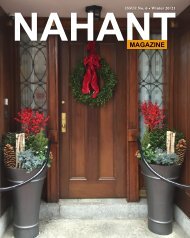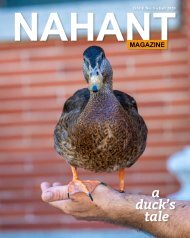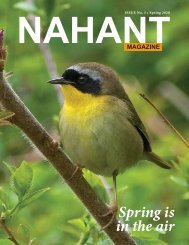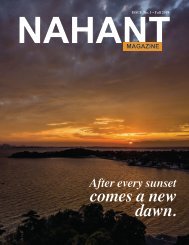Issue Seven Spring 2021
Nahant Magazine is a lifestyle and community based publication focusing on local residents, businesses, real estate, culture, food, drink and more. It’s mailed free to every home in Nahant and distributed to businesses in the area on a quarterly basis.
Nahant Magazine is a lifestyle and community based publication focusing on local residents, businesses, real estate, culture, food, drink and more. It’s mailed free to every home in Nahant and distributed to businesses in the area on a quarterly basis.
Create successful ePaper yourself
Turn your PDF publications into a flip-book with our unique Google optimized e-Paper software.
In Praise of Nahant’s Parklands<br />
and its Seaside Golf Course<br />
By Diane Monteith and Elizabeth Kessin Berman<br />
From the earliest of times, there has always been a desire<br />
to preserve the amazing open spaces of our beautiful island.<br />
Native Americans kept Nahant open for hunting and<br />
fishing; the first European settlers dedicated the island as<br />
pasture land. In the 19th century, Nahant’s first permanent<br />
residents lived on large estates that proudly showcased<br />
open vistas to the sea. Later residents built houses near<br />
the sea, but precious few were exclusive, sea-front villas<br />
that blocked the public’s view of the ocean. As a pleasant<br />
consequence, Nahant has broad and accessible beaches.<br />
We consider ourselves fortunate in <strong>2021</strong> to walk on beachfront<br />
expanses that many towns on the North Shore lack.<br />
Short Beach, Doggie Beach, Tudor Beach, Forty Steps<br />
Beach, and the sea-bordering Willow and Marginal Roads<br />
-- these are much loved wide-open spaces for walkers,<br />
joggers, beach-goers, bicyclists and four-legged creatures.<br />
Over time, parks and playgrounds were added to the Town’s<br />
roster of open spaces. However these recreation areas are<br />
quite remarkable. The playground near Short Beach has<br />
views of the ocean from east and west. The Lowlands is<br />
adjacent to two beaches and the Flash Road fields have<br />
views of beautiful sunsets over Broad Sound. Our children<br />
can play under graciously tall trees at the Library playground.<br />
Marjoram Park overlooks the wharf and Crystal<br />
Beach. There are also two stately memorial parks. One<br />
is on Nahant Road, near the Coast Guard Station, and<br />
the other is at the end of Nahant Road, set between Canoe<br />
Beach and Swallow Cave Road. We also have a park<br />
Nahant Magazine | 26<br />
dedicated exclusively for the birds called the “Thicket.”<br />
The communal effort to preserve Nahant’s open spaces began<br />
in earnest after the middle of the 20th century when<br />
the United States Government classified as “surplus” two<br />
of the last undeveloped areas on Nahant -- East Point and<br />
Bailey’s Hill. These were the areas that the government had<br />
requisitioned for military use. Because of Nahant’s position<br />
on the northern reaches of Boston Harbor, both East<br />
Point and Bailey’s Hill, with their commanding views of<br />
the sea from all points, factored prominently into the nation’s<br />
defenses. Beginning in the 1960s, the Army decommissioned<br />
East Point in two portions. The lower portion of<br />
East Point was first offered to the Town for a purchase price.<br />
But when the Town deferred on the opportunity, some 20-<br />
plus acres were granted to Northeastern University under a<br />
program overseen by the Department of Health, Education<br />
and Welfare. Just a decade later, the Town decided to purchase<br />
the remaining 8 acres of the coastal headlands when<br />
the Government, in turn, decommissioned the higher portion<br />
where the Lodge Mansion once stood. Nearly two decades<br />
later, the highlands of East Point were transformed<br />
into the spectacular Lodge Park under the careful guidance<br />
of Nahant’s first Open Space Committee and others.<br />
Preserving the open spaces of Bailey’s Hill and its neighboring<br />
parcels has its own unique story. When the Army<br />
declared as “surplus” the fortified area of Bailey’s Hill,<br />
the land, other than the military housing, transitioned<br />
to dedicated parkland. But the area adjacent to Bai-<br />
nahant_mag_spring_21_26.indd 26<br />
4/1/<strong>2021</strong> 10:32:48 PM








